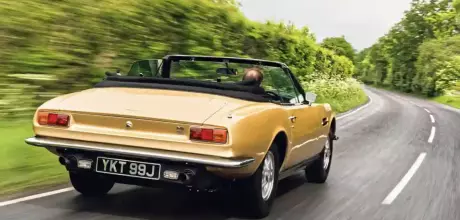1971 Aston Martin DBS Banham Convertible
This DBS Convertible is one of the rarest Aston Martins in existence, yet it remains off collectors’ radars. We drive it, and meet the coachbuilder who created it, Paul Banham.
Words SAM DAWSON
Photography ROB COOPER
Still Thoroughbred Driving one of just six Aston Martin DBS Convertibles
PLUS creator Paul Banham on the last gasp of traditional British coachbuilt specials
Why isn’t the six-off Aston Martin DBS drop-top on collector radars?
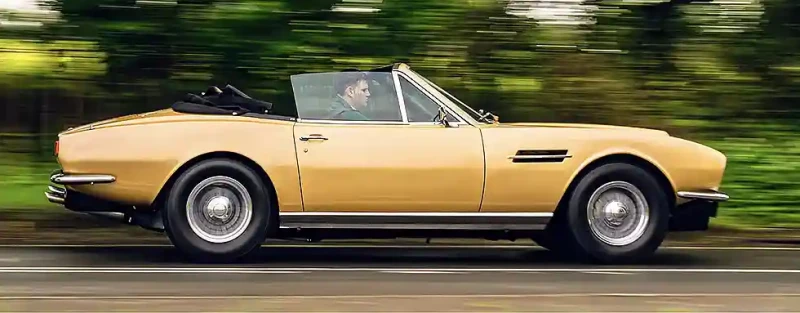
You’re looking at one of the rarest sights in the Aston Martin world; one of just six DBS Convertibles. By way of contrast, a positively profligate 20 DB4GT Zagatos left Newport Pagnell. Admittedly their number was influenced by racing requirements, whereas this is a louche cabriolet designed for decadent cruising. But the most sought-after example of that Aston species is the so-called ‘short-chassis’ Volante, a DB5/6 hybrid convertible built in 1965-1966. They made 37 of those. So why isn’t the DBS Convertible on every serious Aston collector’s wish list?
‘I’m an improvisor, and will consider any technique to achieve the effect I want’
Quite possibly because this DBS was never intended by Aston Martin itself to be a drophead. It left the factory as a fastback coupé (or saloon in Newport Pagnell parlance) and wasn’t officially beheaded until the following decade. And yet, this was essentially how the hallowed FLM Panelcraft DB6 and DBS shooting-brakes came into being.
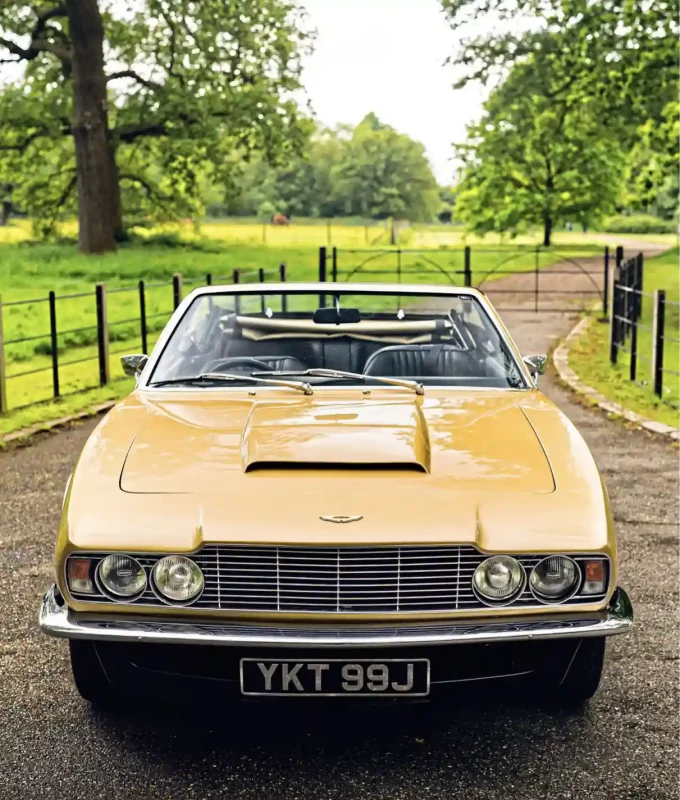
Perhaps, as we shall discover when its coachbuilder, Paul Banham, explains his work, it is down to the era in which it was created. Think coachbuilt special Astons and the image is of ever-so-discreet tweed-jacketed Sixties landowners encouraging beagles under the tailgate one misty Glorious Twelfth dawn – not loud-shirted Kings’ Road poseurs in the heyday of the Chelsea Cruise. But has the Banham DBS Convertible been unfairly tarred with a metalflake-daubed brush?
This example, for sale with JD Classics, is such an elegant piece of craftsmanship. When it’s up, the hood runs flush into the windscreen’s header rail rather than sitting clumsily on top of it like a flat cap’s peak in the manner of Aston’s later in-house V8 Volante design. Sink into the deep-pile, Tempurmattresslike driving seat and feel its instant, relaxing embrace. Flick a pair of tiny teardrop-shaped retaining clips and the roof can be cast backwards with one hand in the manner of an Alfa Romeo Spider’s, largely dropping into a neat well behind the rear seats rather than sitting on top of the deck under a bulky vision-blocking tonneau like a factory Aston.

Viewed from side-on, Banham’s reshaping of the car’s upper and rear aspects lends the DBS a beauty that William Towns’ American-inspired fastback original doesn’t necessarily possess. There’s a set of flowing curves at the back, the inner deck echoing the shape of the outer wing it sits upon rather than forming a brutalist ski-ramp. Traced from front to rear or vice versa, a series of styling lines, carved by angled aluminium surfaces, depart from the jutting upper edge of the prow and neatly separate and rejoin each other twice before ending in a crisp tail panel just big enough to hold the Hillman Hunter-sourced taillights. As I admire the Aston parked up sparkling in Spring sunshine on the gravel driveway of Hylands House, a passer-by viewing it from the rear three-quarters asks me whether it’s some kind of special-bodied Jaguar, saying it resembles a wasp-tailed E-type roadster. Usually, if a DBS reminds anyone of another car, it’s typically a Camaro or a Mustang.
The venerable ‘DB’ straight six is wonderfully sonorous on start-up. Its deep warble gains a twin-cam snarl under throttle load, but this is fundamentally a soundtrack rooted on the racetrack in the Fifties and Sixties. It’s almost at odds with the Mercedes SL-like demeanour of the roof-down DBS, and much noisier at idle than Aston’s whispering V8 is at most speeds – in non-Vantage tune at any rate. Roof up or down, Banham’s work improves on the standard DBS ergonomics. Usually when sitting in a hardtop DBS, the roof seems to sit too low, the windscreen rake too severe for underpinnings with hardpoints apparently rooted in a more upright era, the whole car feeling more claustrophobic than anything so large has a right to. In this, the relatively thin hood yields more headroom at the front, and the notchback roofline creates far more rear seat room too. The hood mechanism eats into already-vast luggage space, rather than the cabin, although this necessitated the re-siting of the fuel fillers, sending petrol pipes running down the back of the boot into an underseat tank. Admittedly it makes the Convertible roof look a bit bulbous when erected – not least because the side windows maintain the downward-swooping lines of the fastback saloon rather than the squared-off angle Aston gave its later V8 Volante, resulting in more fabric above the B-post line – but ultimately, it makes this a more usable car. Was this Paul Banham’s intention?

‘Of course the design was improved!’ the coachbuilder laughs. Although Paul Banham Conversions, his original coachbuilding firm, founded in 1976) no longer exists, he’s still based in Kent, his firm Myrtle Ltd creating bespoke luxury car interiors as well as contributing to high-end classic restorations. ‘The Aston Martin DBS was far too heavy, and not the most finely-judged piece of engineering in the first place. My design went much further than skin-deep – I had to make new tubular sections for the sills, and strengthen both the A- and B-posts to compensate for the loss of the roof structure – Aston’s own rear chassis was like a garden gate!’ Impressively, this hasn’t resulted in overlywide sills eating into the cabin space as it does in Touring’s DB5 Convertible – the extra metal was hidden within the existing aluminium bodywork.
‘I had a DB5 Convertible myself at the time I created the first DBS drop-top,’ Banham continues. ‘I copied its hood mechanism design, then adapted a Triumph Stag hood frame to resemble it – a readily-available new-car part at the time.’ Incredibly, Banham reshaped the rear panels by instinct, rather than making a technical drawing or even a sketch first. ‘It was just about resolving the issue of the rear deck while also making it pleasing to the eye,’ he says. ‘Also, I didn’t want to feel as though I was copying another design.’
I have the Mercedes SL in mind as I set off into the Essex countryside in this DBS. The three-speed automatic six-cylinder luxury-cabriolet configuration is strongly reminiscent of Pagoda and lesser R107 SLs, but the distinctive Borg-Warner whine is more Fifties lorry than Autobahn wafter. The lack of soundproofing from the roof amplifies the noise further, involving me in the action. The pedal layout helps too – unlike a Mercedes, where both pedals are offset to the right, Aston’s broad and double-hinged brake pedal can be operated by either left or right foot, making it easier to drive like a sports car, and the lighter nose than a V8 plus direct steering make it easy to place the DBS even on narrow country lanes. There’s a lovely smooth linearity to the power delivery too, the throttle responding crisply underfoot. The brakes are sharp and powerful, and although the car is composed when the road is smooth, a rut or a pothole will send a shudder of scuttle-shake through the structure, despite Banham’s chassis revisions.
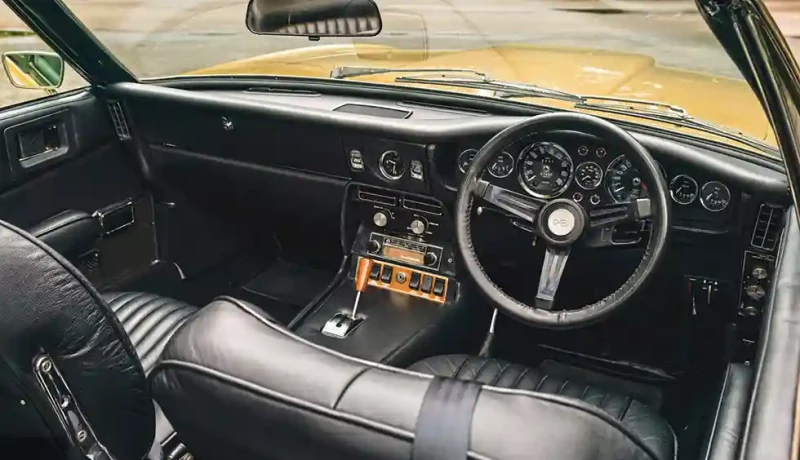
Also, the three-speed auto’s ratios are a little too long to feel sporty. Plant your right foot and it’s an age before it finally shifts up. The DB six sounds glorious under load, but its contralto becomes an irritated drone above 3000rpm thanks to the gearbox. Even when cruising at 40-50mph, it feels like it’s stuck in too low a gear. It’s a ’box more suited to lumbering premotorway luxury saloons than anything with pretensions to slickness, and the same criticism was made of it when the Borg- Warner Model 8 was first fitted to the Aston Martin DB6.
Paul Banham was all too aware of the gearbox’s shortcomings. ‘It was awful!’ he moans, but he didn’t have much choice over specification. And it’s this factor that counts against the DBS Convertible’s desirability. ‘I had no relationship with Aston Martin itself,’ he explains. ‘The cars mainly came to me via second-hand prestige-car dealers who realised they could get more for a convertible car than a fixed-head. There had been a lack of convertibles in that class in the Seventies.’ Apparently impending US legislation to ban convertibles on safety grounds following the Nader Report was partially to blame. Although the proposed regulations never passed through Congress, car companies pre-emptively stopped building cabriolets.
Ferrari offered no Daytona Spider successor. There were no factory Maserati Spyders built between 1973 and 1984. None of Lamborghini’s front-engined GTs came without a roof, Jaguar’s XJ-S was coupé-only, as was the Porsche 928, and even Mercedes hedged its bets with the SLC version of the R107. In addition, interest in Aston Martin convertibles had always been low anyway. Although it was launched in 1967, years before any suggestion of a drop-top ban, Aston Martin hadn’t bothered with a DBS Volante, quite possibly because only around 10 percent of DB4s, 5s and 6s had been roofless. As the DBS supplemented rather than replaced the DB6, Aston figured the DB6 Volante fulfilled the convertible role in its range, but after just 140 were built, it was cancelled in 1971 anyway.
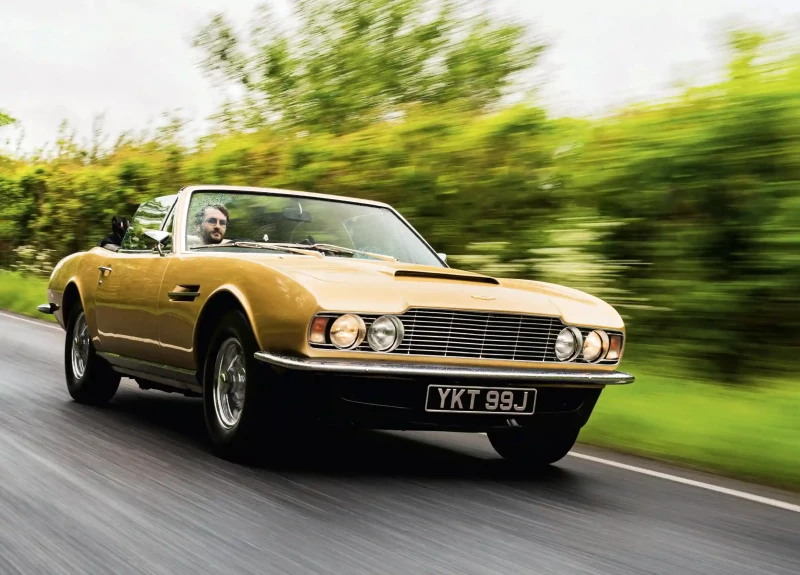
And yet, perhaps it was a case of the market not knowing the value of what it had until it was gone? In Autumn 1973, a littleknown London coachbuilder called Specialised Engineering placed an advert in the Aston Martin Owners’ Club’s quarterly magazine offering its own reworked version of the then-new V8 and six-cylinder AM Vantage. It was accompanied by a sketch showing a targa-roofed car with a distinctly Iso Grifo look to its rear aspect, complete with wraparound rear screen. Specialised Engineering announced that it intended to build the cars in 1974. But then came the OPEC oil embargo, Aston Martin was placed into receivership and built no cars for a year. Specialised Engineering was, seemingly, never heard of again. Paul Banham recalls this dire time for Aston Martin. ‘Their values plummeted,’ he says. ‘DBSs with mechanical issues were as good as scrap at the time and it got to a point where I was pulling them out of gardens, but to an enterprising mindset they presented an incredible opportunity.
‘My first DBS conversion was on a V8 I found around this time for just £3000. The crankshaft had parted company with the engine block, but it was ripe for improvement anyway. People get so reverential about Aston Martins, but in reality those early V8s had porous engine blocks, and under their aluminium bodywork their steel chassis frames were rusting practically straight out of the factory. As well as reworking it as a convertible, I fitted mine with a supercharged Jaguar V12. Interestingly, all the engine mounts for the Aston’s V8 were in just the right place to accept the V12.’
Completed before Aston launched its own V8 Volante, Banham’s supercharged DBS V12 Convertible acted as a shop window, and resulted in him competing with Aston to supply convertibles as the Seventies became the Eighties and the economic climate changed. ‘It was the “loadsamoney” era,’ Banham says with a slight sigh, yet also an acknowledgement that that there was plenty of work available as a result. ‘The demand for open-topped Aston Martins, new or used, was suddenly enormous. Remember that DB5 Convertible I copied the hood design from? I’d got that for £15,000 in the late Seventies, still a relatively large amount of money back then. But not long into the Eighties, a dealer offered me £130,000 for it. That’s how the DBS Convertible succeeded. It wasn’t about Astons specifically – frankly, Jensens are far better cars – but I like cars and it all became a bit of a game.’
It was a game that shocked purists, and Banham is frank and candid about it today. ‘In the mid-Eighties, I met an Irish highend car dealer in London who offered me a Ferrari 400 cheaply at £7000 because it had a dent on its nose. I said yes, but it took me three months to extract the thing from behind a garden centre in North London. When I got to it, I opened the logbook and it read “chassis numbers commence at 2093.” I checked this car’s chassis, and it read 2093 – it was the very first 400 ever made. And I still cut the roof off it.’ Banham’s work on the 400 is intriguing, maintaining the door frames yet slimming the pillars and insetting the canvas. Roof up, it still looks like the coupé.

‘I did it because I wanted to, not to get rich out of it,’ says Banham. ‘By the Nineties, manufacturers had twigged what we coachbuilders had been doing the previous decade and broadened their ranges. I then realised that the best way to make money is to make parts for cars, rather than working on cars. To this day, people approach me asking me to design or build some prototype or other, and I always say no. They always fail.’
Aston Martin was changing too. Ford bought a majority share in the firm in 1987, and began rationalising out many of the inefficiencies of traditional coachbuilding in favour of uniform, semi-volume production. ‘Before that Nineties generation, Aston Martins were very underdeveloped, so there was always room for improvement,’ says Banham. ‘But also, people’s attitudes towards spending money were changing. It’s a mentality that’s affected the kit car world as well as specialist coachbuilding [Banham was a prolific kit manufacturer in the Nineties]. People look at extensive alteration and reworking and say, “Why would you do that?!” They don’t want to take the risk with something so expensive. But I’m of a generation that knew it had to tinker with cars to get what it wanted from them.
‘As a coachbuilder, I don’t see myself as someone like Harold Radford, designing in the traditional way and keeping to the purity of rolled aluminium at all times. I’m an improvisor, and will consider any technique to achieve the effect I want. Jensen understood this, which is why it was such a pioneer. Think of the use of glassfibre on the 541 and the C-V8, for example.’
As I finally get the sluggish gearbox to shift up and settle into a relaxed roof-down cruise along the A414, I find myself trying to place the Banham DBS Convertible into the Aston pantheon. While it lacks the of-the-moment purity of a Radford DB5 shooting-brake conversion, by no means is it a questionable product of the Eighties skirts-and-spoilers aftermarket either.
When Banham converted it, Aston Martin stood on the cusp of a less special era – one of uniform products created to counter similarly productionised cars from rival manufacturers, all built with little margin for eccentricity or alteration, other than a trim swatch here, a paint choice there. The likes of Zagato and Touring still body Astons, but they’re self-consciously exclusive limited editions, rarely seen away from concours lawns.
Whereas, although he downplays the comparisons, there are parallels between Banham and someone like Radford; or Nobby Fry and Robert Lee of FLM Panelcraft. Creating cars which satisfied individual customers’ demands, to order, and drawing upon long-established English coachbuilding traditions to do so, with desirability and exclusivity as a happy byproduct rather than a cynical aim. And with this in mind, the Banham DBS Convertible should by all rights be considered just as desirable as some country-house shooting-brake.
Configuration feels not unlike some Mercedes SLs. It’s much less claustrophobic than the hardtop DBS A desirable model, but it wasn’t always so DBS six-cylinder cars carried over wire wheels from the DB6.
TECHNICAL DATA 1971 Aston Martin DBS Banham Convertible
- Engine 3995cc in-line six-cylinder, DOHC, three SU HD4 carburettors
- Max Power 282bhp @ 5500rpm
- Max Torque 280lb ft @ 4500rpm
- Transmission Three-speed automatic, rear-wheel drive
- Brakes Servo-assisted discs front and rear
- Suspension Front: independent, wishbones, telescopic dampers, anti-roll bar. Rear: de Dion axle, parallel links, Watt linkage, coil springs, lever-arm dampers
- Steering Rack and pinion
- Weight 1587kg
- Performance Top speed: 130mph
- Acceleration 0-60mph: 8.6sec
- Fuel consumption 15mpg
- Cost new £6112
- Value now £125,000
Rear panels display Banham’s talent for eyeballing shapes without technical drawings Three-speed auto doesn’t do the car any favours Six cylinder’s lovely soundtrack evokes a racetrack heritage


